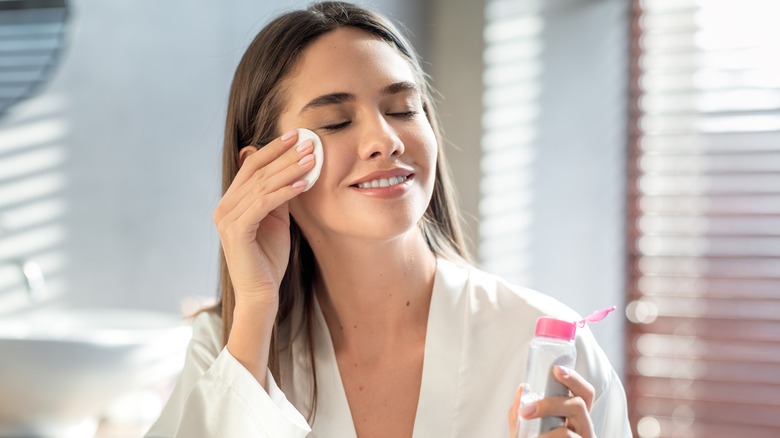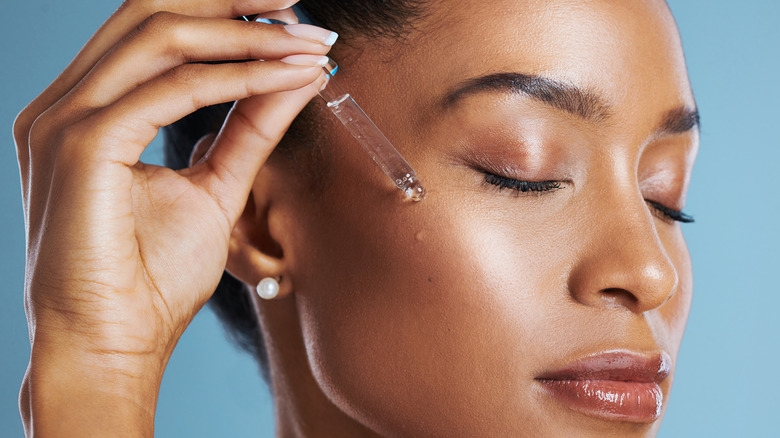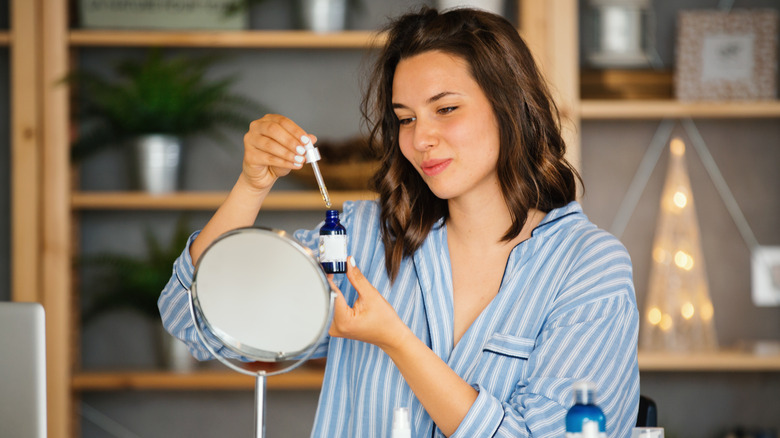Retinol And Glycolic Acid Don't Play Well Together - How To Use Them Both In Your Skincare Routine
Optimizing your skincare routine isn't just beneficial for your skin. It's also good for your wallet and time. Given how expensive many skincare products, serums, creams, and ointments can be and the amount of time it takes to apply each product, it would be a shame to find out after spending money and time out of your packed schedule that the products you've been using aren't effective. That's why the spotlight is currently on glycolic acid and retinol, two common ingredients in modern skincare products that are the cosmetic equivalent of frenemies. Yes, both ingredients can have benefits for your skin, and they have the potential to be effective when both are used in your skincare routine. But they're best kept separated so a riot doesn't break out, or in the case of skin, so that a literal breakout doesn't occur as a result of unknowingly using the ingredients incorrectly.
Skincare products are just like medications you take orally. The active ingredients you apply to your skin are absorbed into your body, thus allowing them to be effective in treating a variety of topical skin concerns. Just as certain medications shouldn't be mixed because of potential interactions, there are skincare ingredients that shouldn't be applied at the same time because of possible reactions. Here's how to handle these skincare frenemies.
Glycolic acid contains irritating chemical exfoliants
The two ingredients carry with them an increased risk of skin irritation, but glycolic acid garners the most attention for exacerbating side effects when combined with retinol, reports Healthline. Initially, there was hesitation about using both retinol and glycolic acid concurrently because of a belief that the alpha-hydroxy acids and-or beta-hydroxy acids (which contain chemical exfoliants) found in glycolic acid immediately eliminate any benefits of retinol. Since this conclusion was widely circulated, additional research has been conducted to examine how the two ingredients interact and their potential reactions. A 2015 study published in Indian Dermatology Online Journal found that a positive relationship exists between the two components, resulting in increased effectiveness in ridding the skin of acne scars by minimizing their appearance and aiding in the rejuvenation process to fill in dimpled pores. Importantly, the relationship between glycolic acid and retinol is neither all positive nor all negative.
On its own, glycolic acid, which is naturally derived from sugar cane, is known for reducing the appearance of dark spots, stretch marks, and fine lines, in addition to reducing acne, per WebMD.
Redness and irritation can occur when combined
The benefits of retinol are similar to those of glycolic acid, though its effectiveness varies. According to Harvard Health Publishing, retinoids and retinol are the same and are a type of topical product containing a strong concentration of vitamin A. Like glycolic acid, retinol has been found effective in treating dark spots and abnormal pigmentation, fine lines, age spots, acne breakouts, and assists with rejuvenating the growth of new skin cells. In a nutshell, retinol and glycolic acid produce very similar results. However, given that retinoids can dry the skin, sun exposure increases the chances of sunburn and irritation. It's one of the ingredients found in skincare products that is most often discouraged from being combined with other components, including vitamin C and benzoyl peroxide.
If you want to use both glycolic acid and retinol, first consult with your healthcare provider, as side effects can include severe skin irritation, peeling, hyperpigmentation, and sunlight sensitivity, according to Healthline. Should you be given the green light, keep a few important things in mind when conducting your morning and evening skincare regimens. Never use the two ingredients at the same time. Instead, wait 12 hours minimum between using the respective products.
Take your time introducing both ingredients
You should know a few more critical bits of information about these frenemy ingredients. According to Healthline, it's best to start using them gradually so you can monitor any negative reactions. Begin with one product and wait until you have a solid regimen before introducing the other ingredient. Be certain your skin doesn't become irritated, overly dry, or experience other side effects. When using both glycolic acid and retinol, maintain 24 hours between using the ingredients instead of the minimum 12 hours.
With retinol, limit application to once per week. Begin with twice weekly for glycolic acid. Both products can eventually be used up to every other day as long as they're applied on alternating days. Always wear sunscreen, even if you don't think you'll be going outside. You can never be too careful with your skin; You'll be living in it for the rest of your life. Stop immediately and consult your healthcare provider if side effects develop.



